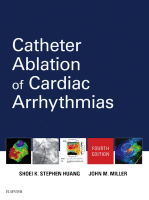Physical Address
304 North Cardinal St.
Dorchester Center, MA 02124

Key Points Children have the same variety of arrhythmia mechanisms as adults, but with a different distribution and often in different clinical settings. Despite physical similarities of older children to adults, children are not just little adults when it comes…

Key Points A detailed understanding of the anatomy of the atrial septum and its relationship with critical structures such as the aortic root and the posterior atrial wall is crucial to safely perform transseptal catheterization. A biplane fluoroscopy-guided technique using…

Key Points Complications can occur in any aspect of catheter ablation procedures. Common and specific risks and complications of catheter ablation procedures are well established. New risks and complications associated with catheter ablation of new target cardiac tachyarrhythmias such as…

Key Points Hemodynamic instability precludes detailed activation and entrainment mapping in a significant percentage of patients presenting for scar-related ventricular tachycardia (Sc-VT) ablation. As a result, ablation of Sc-VT is often limited to substrate mapping and ablation performed in sinus…

Key Points The right ventricular outflow tract (RVOT) epicardium is the culprit arrhythmogenic substrate site of Brugada syndrome (BrS). Abnormal fractionated electrograms and double potential electrograms are localized only in the anterior aspect of the RVOT epicardium. Epicardial and interstitial…

Key Points Tachycardia Mechanism Ventricular tachycardia based upon morphologic/anatomic variants of the congenital heart defect or ventricular incisions and patches/scar tissue Best example tetralogy of Fallot: right ventricular macroreentrant tachycardia through anatomically defined isthmuses, often involving the right ventricular outflow…

Key Points Percutaneous access to the pericardial space has improved our ability to characterize and modify arrhythmogenic epicardial scar substrates. Knowledge of pericardial anatomy and relevant surrounding structures is important for reducing and recognizing complications. Although implementation of epicardial mapping…

Key Points Mapping Arrhythmogenic substrate in ventricular tachycardia (VT) in the setting of structural heart disease is usually living but diseased myocardium within scar, which promotes reentry. This substrate can usually be identified and effectively targeted with ablation in sinus…

Key Points Substrate mapping is performed to delineate the scarred myocardium in unstable ventricular tachycardia (VT). For ventricular fibrillation (VF), mapping is performed to identify the focal origin of triggers. Targets for substrate ablation include VT exit sites identified by…

Key Points Mapping Entrainment mapping focusing on sites with concealed entrainment, pace mapping, electrogram-mapping focusing on sites with fractionated electrograms and isolated potentials Ablation Targets Myocardial fibers within scar tissue Special Equipment Preprocedural magnetic resonance imaging to assess for presence…